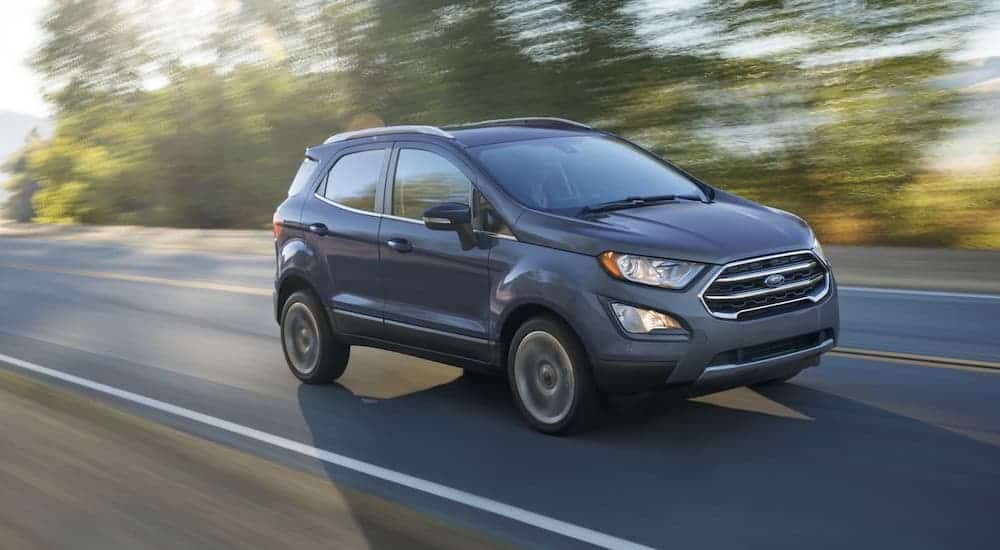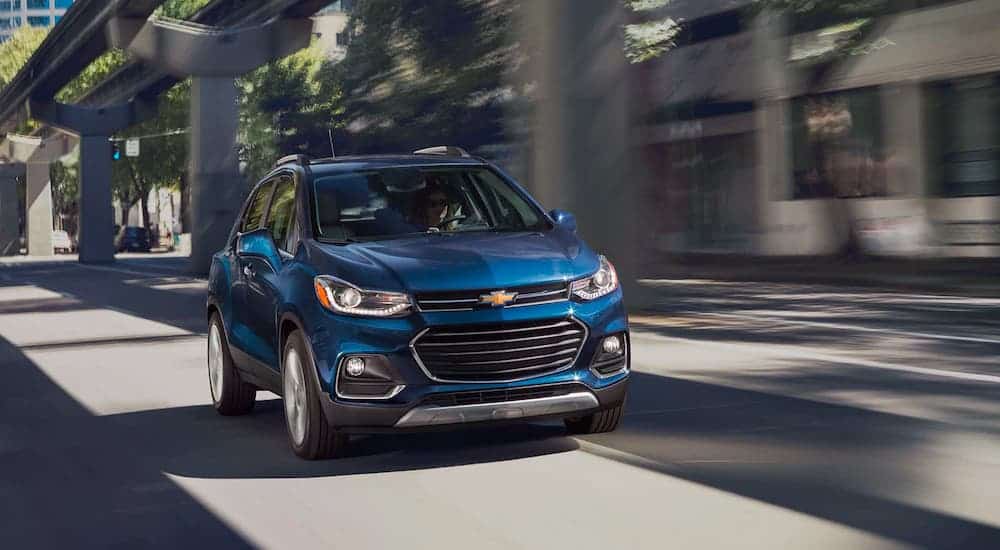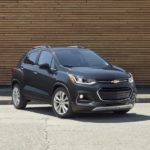With so many compact SUV choices, comparing them all is a challenge fit to make any potential buyer frustrated. It can be hard to know which vehicle will serve you best when there is so much information to read. To make it easier, we are offering to compare two affordable compact SUV models, the 2020 Chevy Trax vs 2020 Ford EcoSport. Here, we’ll take a closer look at the trim a step up from the base on both vehicles, one of the more popular trims buyers choose: the 2020 Chevy Trax LS trim, and the 2020 Ford EcoSport SE trim. The Chevy Trax MSRP for the LS trim is $23,200, while the Ford EcoSport SE is $23,450. Below are the specs of each trim level, and a detailed look at the features each vehicle offers.
Engine and Performance
Chevy’s Trax LS comes with a 1.4-liter four-cylinder turbo engine. The option to upgrade to all-wheel drive is offered, but it comes standard with front-wheel drive and a six-speed automatic transmission. Ford’s EcoSport SE is outfitted with the 1.0-liter three-cylinder turbo engine. This vehicle also comes with the option to upgrade to all-wheel drive, but comes standard as front-wheel drive with a six-speed automatic transmission. Both vehicles get a combined fuel economy of 28 MPG. Despite the similar fuel economy, the Trax has the better engine for power.
Interior
Both the Chevy Trax and Ford EcoSport come standard with upgraded cloth seats, seating capacity for five, cruise control, a cargo cover, tinted rear windows, powered driver’s seats, and have a folding rear seat. The cargo capacity for Chevy’s Trax is 18.7 cubic feet, while Ford’s EcoSport has 20.9 cubic feet. Another slight difference between the two vehicles is the Trax has a powered lumbar feature on the driver’s seat and remote start, while the EcoSport has automatic climate control and keyless entry.
If you plan to have taller people riding in either of these vehicles, the back seat is not the place for them to sit. Neither of these SUVs is built with large back seats, though front seating should accommodate most people comfortably. Additionally, the Trax offers a small drawer under the front passenger seat for extra storage, while the EcoSport has a moveable cargo floor. One last difference between the two interiors is that the EcoSport has heated seats, while the Trax has a 110-volt outlet.
A noteworthy criticism of the EcoSport is to mention the low-cost appearance of the interior. While the interest may be to keep costs low, the interior of the EcoSport appears cheap with hard-touch surfaces and inexpensive materials overall. To have a more upgraded look, the buyer would need to purchase a more expensive trim, while the Trax has a slight advantage with a more attractive interior, including more options for interior colors.

Exterior
These vehicles have a lot in common, with LED daytime running lights, roof rails, 16-inch alloy wheels, and automatic headlights. Differences lie in details like the Trax having heated exterior mirrors, while the EcoSport has a windshield wiper de-icer, both handy during winter months. Each of these compact SUVs has a fairly small footprint to make negotiating parking and tight driving conditions easier, with the Trax at about 167 inches in length, and the EcoSport at about 161. The Trax is also slightly taller at 66 inches, while the EcoSport is 64.8 inches.
In terms of size, you may feel the smaller size of the EcoSport is better, but the engine gets bogged down when you add people and cargo. Unless you upgrade to the larger engine with the all-wheel drive, you may find this vehicle isn’t worth the smaller footprint. Lastly for this trim level, the Trax upgrades the headlights, while the EcoSport has a sunroof. The sunroof and interior storage space may be a draw for some, but be wary of the engine that may not be able to handle the load when you actually utilize that extra cargo space.
Infotainment and Tech
Bluetooth connectivity, Apple CarPlay and Android Auto all come standard on the trim levels for both the EcoSport and the Trax, which may come as a pleasant surprise for buyers purchasing vehicles offered for such low prices. Along with those tech amenities, each of the vehicles being compared offers satellite radio, a 4G LTE WiFi hotspot, rear-view camera, six-speaker audio system, and two USB ports. Both vehicles are well-equipped with tech for the modern driver, though there are a few differences in additional tech offered by Ford and Chevy.
The Trax comes with a seven-inch touchscreen and On-Star, while the EcoSport comes with an eight-inch screen and a Sync 3 interface, which connects your vehicle to Alexa and helps navigate traffic via the in-car app. Chevy’s Trax also comes with the MyLink app, which connects compatible smartphones with navigation, streaming, and managing driver patterns, among other features. When you compare the uses of each in-vehicle app, there are a wide range of uses which come down to buyer preference.
Sync 3 allows the driver to utilize voice commands, steering wheel-mounted buttons, or use of the touchscreen to control the program. It allows you to access streaming and compatible apps from your smartphone to be funneled through the vehicle’s audio and infotainment system. MyLink also allows the driver to be hands-free while driving, and it offers Siri Eyes Free as a challenge to EcoSport’s Alexa connectivity. Again, it may be up to driver preference in terms of which vehicle’s tech suits the buyer. Both offer comprehensive phone connectivity and entertainment options.
Safety Features
Here, we see probably the largest divergence of features between the almost evenly-matched vehicles thus far. Driver-assisted safety features are specific to the manufacturer in some ways, even though some of the features overlap. In the case of the EcoSport, integrated blind-spot mirrors are not technology necessarily, but are mirrors within the exterior side mirrors, which essentially angle in a way that reduces the natural blind spots on any vehicle. A blind spot information system is the tech that will alert the driver if another vehicle on the road moves into the driver’s blind spots. The NHTSA gives the EcoSport an overall safety rating of four stars.
For the Trax, you have side blind-zone alert, which alerts the driver in case of a potential collision. Forward collision alert gives the warning that brakes should be applied to avoid a collision with a vehicle ahead of the Trax. Lane departure warning will alert the driver if the vehicle drifts out of the current lane without using a signal. The NHTSA gives an overall safety rating of five stars to the 2020 Trax, and this vehicle is the clear front-runner when it comes to driver-assisted safety features.
Summary
Overall, many of the features of these vehicles are so similar it’s a toss-up which will be the better vehicle. In some cases, it may come down to a buyer’s preference when actually sitting in the vehicle or taking it for a test drive. On the other hand, when you look at safety features, particularly, the 2020 Chevy Trax is the clear choice in terms of safety ratings and driver-assisted tech. Engines are also another point of divergence, with the Trax winning out that round, too. One last point of comparison is the quality of the interior, which also falls to the Trax. If you want to save a little on the price, the Trax may be the better choice if you’re seeking a compact SUV that embraces the modern age.





